|
HOME DIGITAL MEDIA ARTICLES
|
Manifest Technology Blog
-- Site:
| Articles
| Galleries
| Resources
| DVI Tech
| About
| Site Map
|
Articles:
| PC Video
| Web Media
| DVD & CD
| Portable Media
| Digital Imaging
| Wireless Media
| Home Media
| Tech & Society
|
Home Media:
| Home Media Articles
| Home Networked Media Gallery
|
Edward Tenner / Body Technology:
Thumbs, Cameras, PDAs, Video Games
(6/2003)
by Douglas Dixon
Tenner
Body Technology
Tiny Cameras
Tinkering
Handheld Devices
Computer Games
The Starfighter Generation
References
"The thumb is coming back to computing," writes Edward Tenner in
his new book, "Our Own Devices: The Past and Future of Body Technology"
(Knopf, June, 2003). "In Japan today, there are so many new data entry
devices that young people are called 'oyayubi sedai', the Thumb
Generation." Tenner cites the work of one British researcher who has found
that "thumbs around the world are becoming stronger and more skillful. Some
young Japanese are now even pointing and ringing doorbells with them."


"Our Own Devices" explores the history and development of
technologies that protect and enhance our bodies, from our heads (helmets and
eyeglasses) to toes (sandals and sneakers), fingers (musical and typewriter
keyboards), to backs (chairs and recliners). Tenner concludes the book with a
short epilogue on the future of the man-computer interfaces, celebrating the
resurgence of this lowly thumb for interaction with digital devices.
While the interface to desktop computers has been dominated by the
quaintly-named mouse, the thumb now drives laptops and handheld devices, with
thumb sticks, thumb pads, and thumb keyboards. As humans past have adapted to
shoes and chairs, and then more recently to keyboards, our current digital
generation is now adapting to small thumb-based devices for portable
communication, reference, and computing.
Meanwhile, the next generation has blown past such simple interfaces to adopt
video game controllers, allowing real-time control of complex actions --
steering, jumping, shooting -- using simultaneous thumb and finger actions on a
profusion of controls and buttons.
Edward Tenner is an independent writer, speaker, and consultant on technology
and culture (www.edwardtenner.com). He
is currently a Senior Research Associate at the National Museum of American
History. Tenner received the A.B. from Princeton University and the Ph.D. in
history from the University of Chicago, and then held teaching and research
positions in Chicago before becoming science editor of Princeton University
Press.
In 1991 Tenner received a Guggenheim Fellowship and was appointed a visitor
at the Institute for Advanced Study, where he began a project on unintended
consequences of technology. This work was published in 1996 as "Why
Things Bite Back: Technology and the Revenge of Unintended Consequences"
(Knopf 1996, Vintage paperback 1997).
"Why Things Bite Back" explores examples of what Tenner calls
"revenge effects," unforeseen, ironic, and often unpleasant
consequences of the adoption of new technology. The book ranges widely across
medicine, the environment, the computerized office, and sports. Tenner's
research provides interesting perspectives on these issues, and suggests that
much more thought needs to be applied to anticipating and addressing the
unexpected side of progress.
In 1995-96 Tenner turned to the history of human interactions with everyday
objects as a fellow of the Woodrow Wilson International Center for Scholars,
which has led to "Our Own Devices." He also has been visiting
researcher in the Princeton departments of Geosciences and English and at the
Rutgers Center for Historical Analysis.
Tenner's new book explores the historical development of "body
technology," in the sense of both physical devices that modify how we
interact with the environment, and the techniques used to apply them. The result
is a cycle of innovation, in which changes in the behavior of people lead to
further enhancements by inventors and manufacturers. Tenner first demonstrates
this interplay between technology and techniques by examining improvements in
athletic equipment and achievement, for skaters, rowers, fencers, and bowlers.
The book then contains nine chapters that explore the historical development
of human adaptations to the environment. Tenner begins with nursing and bottle
feeding, and then moves on sandals, designed to protect the feet, and then more
recent developments with sneakers, designed both for speed and comfort. He
traces the development of both technology and social norms across different
cultures, some from antiquity, and examines the benefits, and costs, of the
resulting adaptations. For example, while the human body was designed for
walking in bare feet, it now seems that we need at least some sort of sandal to
protect us from both physical and biological hazards in modern streets and soil.
After walking through footwear, Tenner then moves on to how we sit,
discussing the development of chairs as devices for good posture for working,
and then reclining chairs for good health and relaxation. Again, our bodies have
adapted to sitting in chairs so well as part of our modern life that we are no
longer comfortable sitting on the ground. And yet we all seem to have back
problems, which only can be addressed with the latest ergonomic chair designs.
Tenner then moves to the fingers, detailing the development of musical
keyboards and then typewriter keyboards. Here it appears that the human was more
adaptable then expected by the original developers of these devices, able to
unconsciously flow thought and patterns through the fingers, even chording
multiple keys at the same time and different musical lines on the two hands.
While the traditional piano keyboard and QWERTY typewriter layout clearly could
be improved to be easier and more efficient to use, their designs have been
locked in by widespread use, both in equipment and in human adaptation and
training.
Continuing up the body, Tenner then explores eyeglasses and helmets. The use
of helmets as protective exoskeleton has obviously altered the practice of
warfare during the ages of hand-to-hand combat, and also more recently had an
important role in reducing injuries from artillery in the two world wars. But
eyeglasses, Tenner argues, do not just augment and correct our vision, as
required in a literate population, they also are strongly associated with
myopia. He quotes numerous studies that show rates of myopia increasing with the
spread of more schooled populations, and with the number of hours spent in
classrooms. While he admits genetic predisposition and environment factors such
as poor lighting, Tenner also suggests the possibility that correction at early
ages may change the growth of the eye in children and therefore aggravate the
problem.
The book concludes with a short epilogue on the thumb, and the possible
future of man and machine fused into a cyborg, eschewing mere wearability for
implantation of digital devices.
"Our Own Devices" is a fascinating walk through the development of
these "body technology" devices, and the social adaptations of the
techniques for using them. Tenner's writing ranges widely across society and
business, history and cultures, and deeply into the individuals and companies
that developed and marketed these products.
The book is not a quick read, but more to be consumed in moderate servings.
You will come away armed with fascinating facts about common human objects, and
perhaps a desire to pay more attention to the design of your shoes and chairs,
although Tenner does not provide strong conclusions or recommendations about
best practices in using these technologies in today's society. Oddly, Tenner
provides surprisingly few illustrations to help show the evolution and details
of the designs he discusses. More diagrams like the great tree chart of helmet
designs through the ages would have been helpful, for example, in illustrating
the "seven and only seven styles of shoe."
While not Tenner's focus, you also can read the book as homage to the human
propensity for tinkering, as individual inventors and users of these devices
just couldn't stop messing around to try to improve them. In many cases, these
people worked in the face of strong resistance from the medical community and
society at large (think of the past evils of nursing, flat feet, and sneakers).
Yet we're clearly better off because they could tinker and experiment with new
ideas and design concepts.
Tenner calls for "a return to the collaboration between user and maker
that marked so many of the great innovations," citing 1980s studies that
found up to 77 percent of innovations in high-tech manufacturing were initiated
by users. The importance of tinkering also is the central theme of Edward
Felton, a computer science professor at Princeton University who is
concerned about attempts to legally regulate the use of technology. His Freedom
to Tinker site discusses "your freedom to understand, discuss, repair,
and modify the technological devices you own" (www.freedom-to-tinker.com).
Beyond walking and sitting and typing, the major theme of our digital age is
augmenting our memory by bringing stuff with us to remember and record
information and events. And this of course demands miniaturization, as we run
out of room to put all these gismos, in our pockets, clipped on the belt, or
lugged in a shoulder bag. But at some point, smaller becomes too small, as we
can no longer read the small displays or fit our fingers on the tiny buttons.
Consumer electronics companies face this problem as they keep shrinking the
size of digital still cameras and video camcorders that we want to use to
record our lives. For example, Sony's new DSC-U20 miniature digital camera
is about the size of four packs of gum (3 1/4 x 1 1/2 x 1 inch). This is not
just a toy camera, with 2 mega pixel resolution, flash and close-up capabilities
(but no zoom), and standard Memory Stick storage for lots of photos. But while
obviously this size camera can fit in a pocket, the question becomes whether
it's getting just too small to be useful, especially with a tiny LCD display
(less than 7/8 by 5/8 inch).
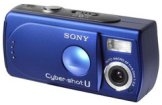 Sony Cyber-shot DSC-U30
Sony Cyber-shot DSC-U30
It turns out, however, that this camera design still works. While you can't
see sharp detail in the display, you certainly still can frame your shot. Also,
buttons are not a big issue with a digital camera; all you need is the one
(reasonably sized) button to click the pictures. Yes, there are a few more
buttons to control the menus when needed, but the major challenge to using them
is good eyesight and viewing conditions to read the menu display. Overall, teeny
tiny still works in a digital camera.
This is not true with camcorders, however, as digital miniaturization seems
to have hit a limit to human adaptability. In camcorder design, the overall size
is limited by the form factor of the tape cassette, which then limits the design
of the tape transport. The physical design challenge then is to find room on the
case for all the components and interfaces: the lens on the front, the
adjustable eyepiece on the back, the adjustable LCD display on one side, the
tape compartment on the other, not to mention the battery, and connectors for
power, video, and computers. Of course, camcorders also need lots more controls,
including dedicated buttons for power, play / record modes, zoom, exposure, and
focus, all of which must be relatively easy to access. And you need a second set
of buttons for playback, plus miscellaneous other controls to access the other
fancy features and modes.
The DV format for digital video camcorders provides a nice balance of
size and function. The DV cassette format is about half the size and thinner
than the analog 8 mm cassette. This permits small camcorder designs that weigh
less than one pound, even with a 2 1/2 inch LCD display. But Sony wanted even
smaller, and therefore introduced the MICROMV digital cassette, smaller
and thinner than half a DV cassette. This is smaller than a matchbox, or you can
visualize it as about the size of two quarters side by side.


But it seems that Sony went too far with its first generation of MICROMV
camcorders. The DCR-IP5, introduced in January 2002, weighed only 12 oz,
with battery, and measured just 1 7/8 x 4 x 3 1/8 inches. The new DCR-IP55,
introduced in August 2002 actually is a bit larger than the previous model, at
15 oz without battery, and 2 3/8 x 2 7/8 x 5 1/8 inches. Users found the first
models just too small and too clumsy to use.
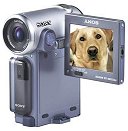
 Sony MicroMV DCR-IP5 camcorder
Sony MicroMV DCR-IP5 camcorder
To deal with the profusion of tiny buttons, camcorder manufacturers have
moved to touch screen menu interfaces on the LCD display. In this way, common
functions such as the VCR play controls can be accessed as buttons overlaid on
the video screen, and more obscure options can be provided in the nested menus.
The result is an end to button bloat, replacing dedicated physical buttons with
virtual controls, and leaving more room for the more important buttons that need
to be controlled by your fingers.
Unlike consumer electronics devices, handheld computing devices tend to
shrink to become all display, and the space for buttons is minimized. Yes,
laptops have keyboards, but the control interface is through the touch pad
and/or pointing stick (as popularized by the IBM ThinkPad), with fingers and
thumbs moving the cursor and pressing the touchpad buttons. But the latest
development in laptops is tablet PCs, all screen or with detachable screen,
controlled by touch-screen and pen interfaces.
Meanwhile, PDA (personal digital assistant) designs are dominated by the
display, with a handful (as it were) of dedicated buttons for scrolling and
common applications. The original Palm PDAs also included a dedicated
writing area, but this also is being subsumed into the touch-screen display in
some newer models. Sony then added a jog dial control to provide for one-handed
navigation in its Palm-based CLIE handhelds.
These devices still are limited for fast data entry. Users either must adapt
their writing style to the device's recognition capabilities, or peck away with
a stylus on an on-screen keyboard (still in QWERTY layout). On the other hand,
cell phones and pager / communicators are focused on the buttons, with a smaller
display and the numeric phone keypad or an alphabetic keypad for messaging.
Phone users can adapt to these devices by becoming practiced at one-handed
dialing, and experienced text messaging users adopt a two-thumbed technique for
faster typing.
But then these devices start to converge, as phones acquire PDA capabilities
and larger displays, or PDAs acquire more buttons for faster data entry. The Kyocera
7135 is a flip-top phone design that happens to have a Palm inside, and
therefore has a full Palm color display, plus the dedicated buttons and writing
area above the keypad.
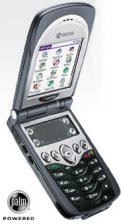 Kyocera 7100 series
Kyocera 7100 series
On the PDA side, Sony now offers CLIE flip models with a
full QWERTY keyboard squeezed into the PDA form factor. Palm's new Tungsten
model provides dedicated buttons on the bottom third of the device, and then
slides open to reveal the traditional Palm writing area. Several of these models
include QWERTY keyboard buttons on the exterior, so they can be used without
needing a stylus. The Tungsten W then combines wireless communication,
supporting E-mail access and phone use (with earpiece).
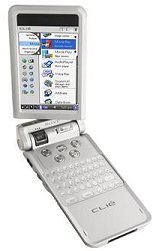 Sony CLIÉ handheld
Sony CLIÉ handheld
The dexterity challenge with these digital cameras and handheld devices is
driven by the miniaturization, providing enough room for the thumb or finger to
press on the desired button without accidentally mashing several others by
accident. With accurate thumbs, you can learn to peck out non-trivial messages,
and even use modifier keys for capitalization and symbols. But these
accomplishments pale against the skills of the video game generation, using
their multi-button controllers to direct movement and actions with split-second
accuracy.
Today's video game controllers have gone far beyond the original Atari-style
joystick, with its single red action button. In the old days, you could only
use the stick to indicate a general direction (up, down, left, right, and
sometimes diagonals) and press the button to cause an action (typically shooting
at something). These were mass-produced devices designed to take a heavy
beating, and therefore did not provide much subtle control.
The simple joystick evolved to replace the stick with directional pads and
add more buttons. Systems such as the Super Nintendo used a rounder and
flatter design that was intended to be held and operated with both hands. The
left thumb operated a directional button, typically implemented as an analog
tilt sensor that could provide more subtle graduations of direction and speed.
The right thumb had access to four buttons to choose and control actions. And
the index fingers wrapped around the front of the control to access two
additional buttons. With these multi-button designs, players could perform
multiple simultaneous actions, moving and jumping and attacking at the same
time, and even switching between different tools. Of course, the ultimate
control was reserved to gamers on PCs, who could map each key of the keyboard to
dedicated actions.
Video game controllers continued to evolve, adding even more buttons and
moving to more of a boomerang or batwing design style. The controller for the Microsoft
Xbox system now includes three thumb pads: an eight-way directional pad for
the left thumb, and both left and right analog thumb sticks. It also has a set
of six pressure-sensitive multicolored analog buttons high along the right side
(two for less common uses), two shoulder trigger buttons for the index fingers,
plus dedicated start and back buttons. Plenty to keep the fingers busy.
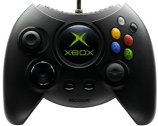 Microsoft
Xbox Game Controller
Microsoft
Xbox Game Controller
The Xbox controller also is rather plump, to make room for two slots for
memory cards and other peripherals, plus motors for a built-in
"rumble" feature. Some gamers found the original controller too bulky,
and preferred the smaller Japanese model. Microsoft also released the newer
smaller Xbox Controller S with a revised button layout, since some users just
could not stretch their fingers and thumbs so easily, and kept finding
themselves pressing buttons accidentally. Now gamers can pound away, with
Microsoft's promise of "comfort, pinpoint accuracy, and total
control."
All this manual dexterity training may well pay off, and not just for virtual
car theft and future high-tech jobs in testing video games.
Researchers at the University of Rochester reported in the journal Nature in
May 2003 that action video games can significantly improve visual skills. Avid
game players can monitor more objects in their visual field (up to 30 percent
more objects) and do so more quickly than nonplayers. Even as few as 10 hours of
game playing was enough to significantly increase a person's visual awareness.
The researchers suggest that "action game playing might be a useful tool to
rehabilitate visually impaired patients or to train soldiers for combat."
This was the premise of the 1984 movie "The Last Starfighter,"
in which Robert Preston played an alien recruiter who seeded Earth with video
games to find candidates for the Star League, to "defend the frontier
against Xur and the Ko-Dan armada." Of course, the best of our planet
turned out to be some kid dreaming of escaping the Starlite Starbrite trailer
park, who beat the game and was blasted off to the planet Rylos to save the
universe. See what an itchy trigger finger can do for you.
The future of human-computer interfaces may well be much like that shown in
the 2002 movie "Minority Report," in which the Tom Cruise
character used a virtual reality visual interface to search a database of visual
imagery that floated in the air before him. Our modern life requires this
ability to track and comprehend multiple sources to the periphery of our visual
field, and to switch attention rapidly to manage simultaneous inputs and tasks.
Whether driving on highways while monitoring your GPS travel routing display
and talking on a cell phone, or watching TV while working on homework and
instant messaging with several friends, our lives demand multi-tasking -- both
attention and action. In the absence of thought or voice input, the resurgent
thumb will press forward as the interface between us "wetware" humans
and our digital devices.
Edward Tenner
www.edwardtenner.com
Our Own Devices: The Past and Future of Body Technology
Edward Tenner
Knopf, June 2003, ISBN 0375407227
Why
Things Bite Back: Technology and the Revenge of Unintended Consequences
Edward Tenner
Vintage Books; Reprint edition, September 1997, ISBN
0679747567
Sony Consumer Electronics
www.sonystyle.com
Cameras www.sony.com/cameras
Camcorders www.sony.com/camcorders
MICROMV www.sony.com/micromv
CLIÉ
www.sony.com/clie
CLIÉ
www.sonystyle.com/clie
Palm PDAs
www.palm.com - now
www.palmone.com/us
Kyocera 7135 Palm phone
www.kyocera-wireless.com/7100_phone/7100_phone_series.htm
Video Game Controllers
www.gamespy.com/hardware/june02/sticks1/
www.gamespy.com/hardware/june02/sticks2/
Microsoft Xbox Game Controller
www.xbox.com/system/Xbox+Game+Controller.htm
|
